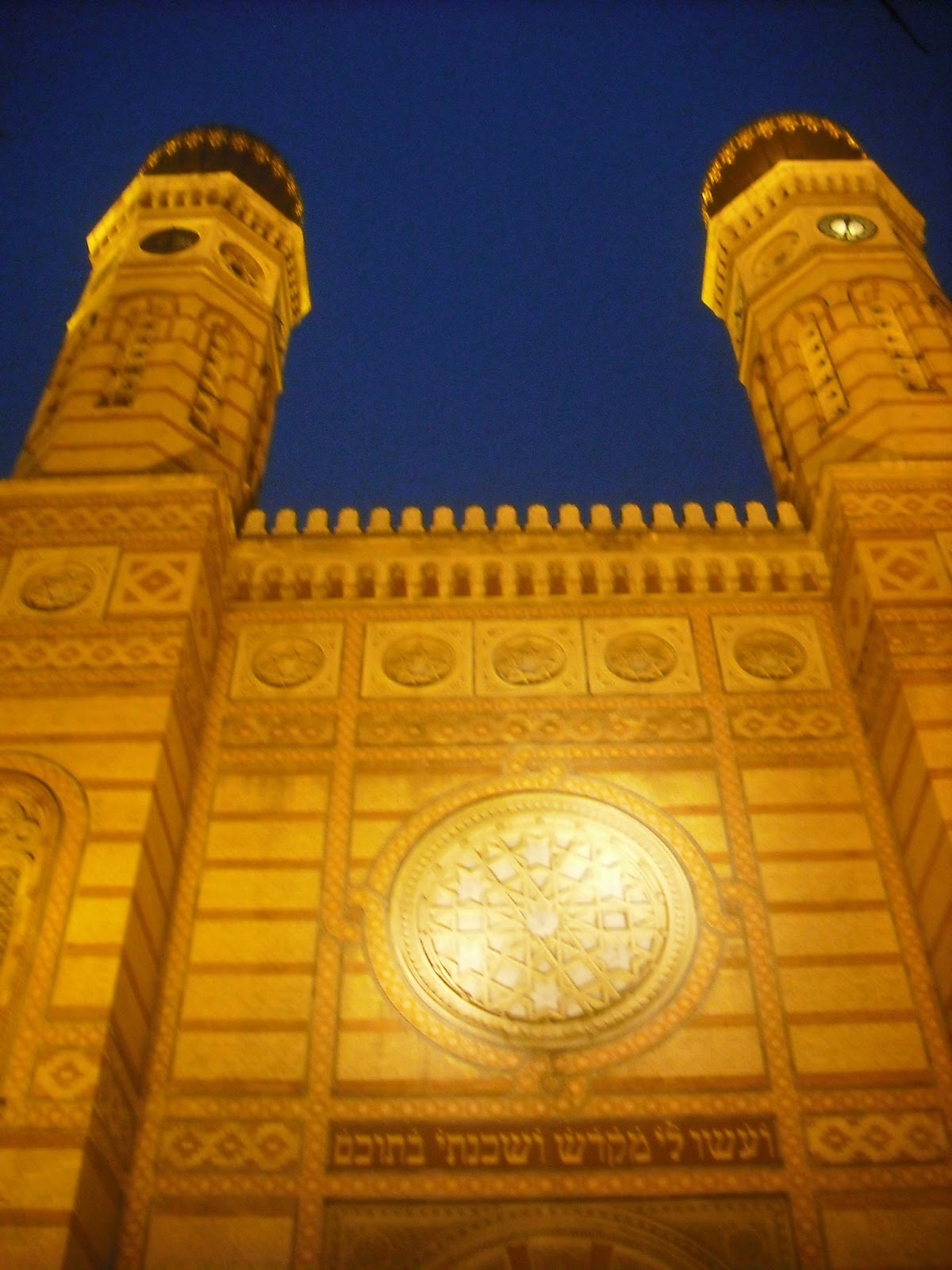The Dohány Street Synagogue, also known as the Great Synagogue, seats around 3,000 people and is the largest synagogue in Europe and the fifth largest in the world. It was built between 1854 and 1859 in the Moorish revival style.
 |
| In the dark it's hard to see the red and tan colored brick work. |
 |
| The domes are black with bright gold trim around the circumference. |
In the 1850's when the synagogue was built, the surrounding neighborhoods were primarily Jewish. In the late 1800's and early 1900's, around 5% of Hungarians were Jewish, and in Budapest, around 20% of the population was Jewish.
In 1939, the synagogue was bombed by the Hungarian pro-Nazi Arrow Cross Party. In October, 1944, the Arrow Cross Party came to power in Hungary, established the Ghetto of Pest, and forced over 70,000 Hungarian Jews to live there. During the winters of 1944 and 1945, over 8,000 Jewish inhabitants died from cold and starvation. Over 2,000 people were buried in the synagogue courtyard.
 |
| Synagogue courtyard and cemetery. |
The Arrow Cross Party led the Hungarian government until March, 1945 when the Soviets liberated Hungary. During this period of 17 months, 10-15 thousand people were killed outright, and another 80 thousand people were deported to concentration camps in Germany. Many of these people were Jewish. In memory of these lives, the Memorial of the Hungarian Jewish Martyrs was erected in 1989 (the year communism is dissolved in Hungary). Shaped to form a weeping willow, the 400,000 leaves symbolize the estimated 400,000 Jews killed in the Holocaust. Many of the leaves have the names of victims carved on them.
There is also a memorial to the Righteous Among the Nations. These include:
- Carl Lutz, a Swiss Vice-Consul in Budapest from 1942 to the end of WWII, who saved almost 10,000 Hungarian Jewish children by issuing Swiss travel documents. He then saved thousands more people by negotiating a deal with the Hungarian government and Nazis which allowed him to grant immigration papers to 8,000 Hungarian Jews to emigrate to Palestine. Lutz deliberately interpreted this quota as applying to families, rather than individuals, in order to save more lives, and then, even after allowing 8,000 Hungarian Jewish families to leave Hungary, continued to issue protective letters with numbers between 0 and 8,000. His heroism did not end here - he also set up 76 houses in Budapest, declared the annexes of the Swiss legation and therefore off limits to Hungarian or Nazi soldiers, and sheltered Jews in these safe spaces.
- Raoul Wallenberg, who while serving as a diplomat in a special envoy to Budapest between July and December 1944, issued Swedish passports to Jews and sheltered Jews in buildings designated as Swedish territory. He is credited with saving between well over 10,000 lives. In 1945, he was accused of espionage by the Soviets, imprisoned, and died while still in Soviet custody in 1947.
- Giorgia Perlasca, who saved over 5,000 lives by assuming the identity of the Spanish consul-general. In 1943, with other Spanish diplomats, he issued documents to protect Hungarian Jews and allow them to leave the country. He also set up safe houses using by annexing buildings for Spanish embassy use. In November 1944 however, Sanz Briz, the head diplomat, was moved from Hungary to Switzerland, which would have ended the Spanish presence in Hungary. Perlasca chose to stay in Hungary, and when the Hungarian government ordered the Spanish Embassy cleared out, Perlasca announced that Sanz Briz was returning, but in the mean time, he had been appointed the substitute. During the winter of 1944, he continued to issue protective citizenship of Spain to Hungarian Jews. After the war, Perlasca told no one of his heroism, until 1987, when a group of Hungarian Jews he had saved found him.
- Angello Rotta, the Apostolic Nuncia to Budapest during WWII. In 1944 and 1945, he issued over 15,000 baptismal certificates (back dated to show infant baptism) and protection papers which allowed travel to Palestine to Hungarian Jews.
Today, the synagogue's ark contains torah scrolls from several synagogues destroyed in the Holocaust and the synagogue continues to serve the Jewish population of Hungary.






No comments:
Post a Comment